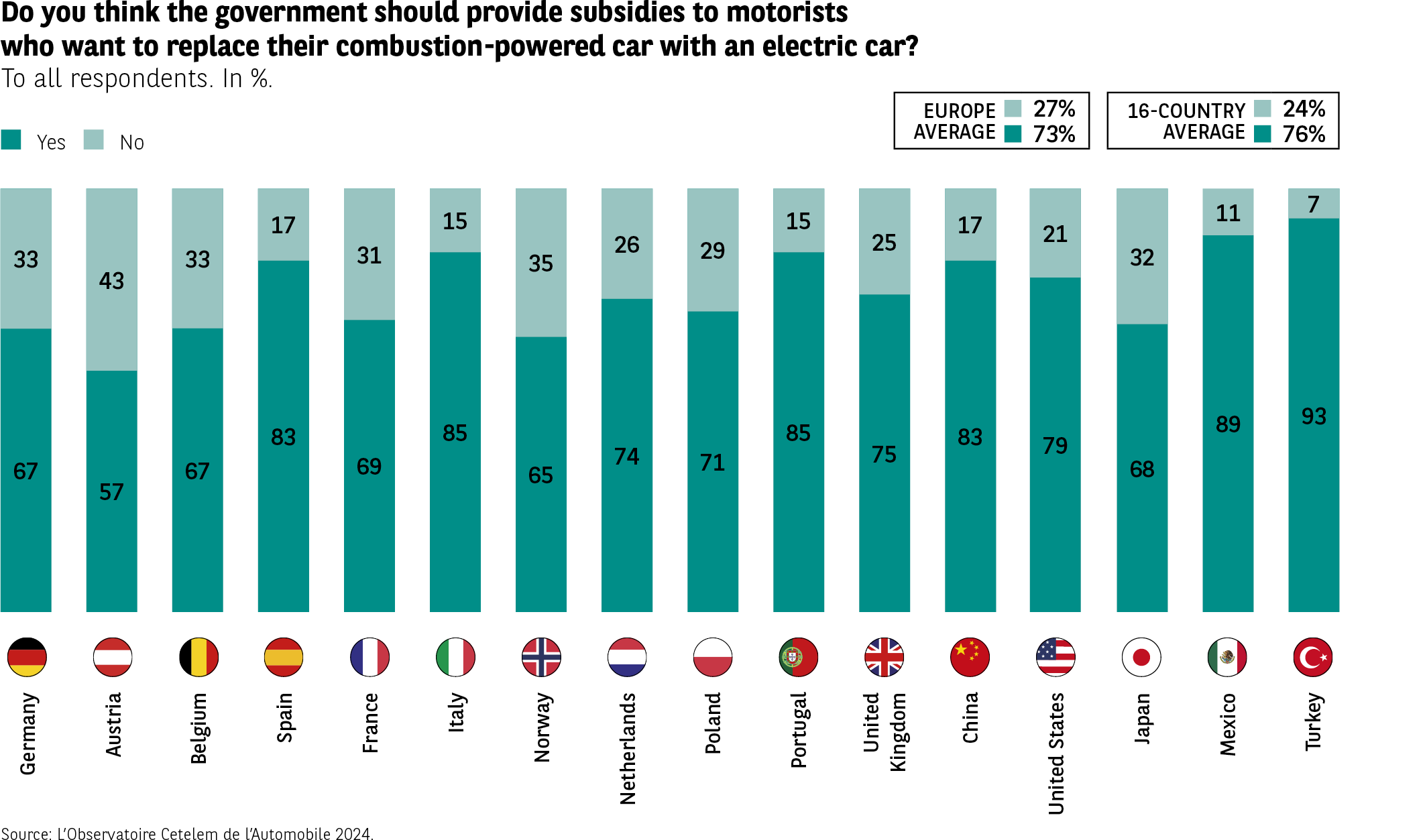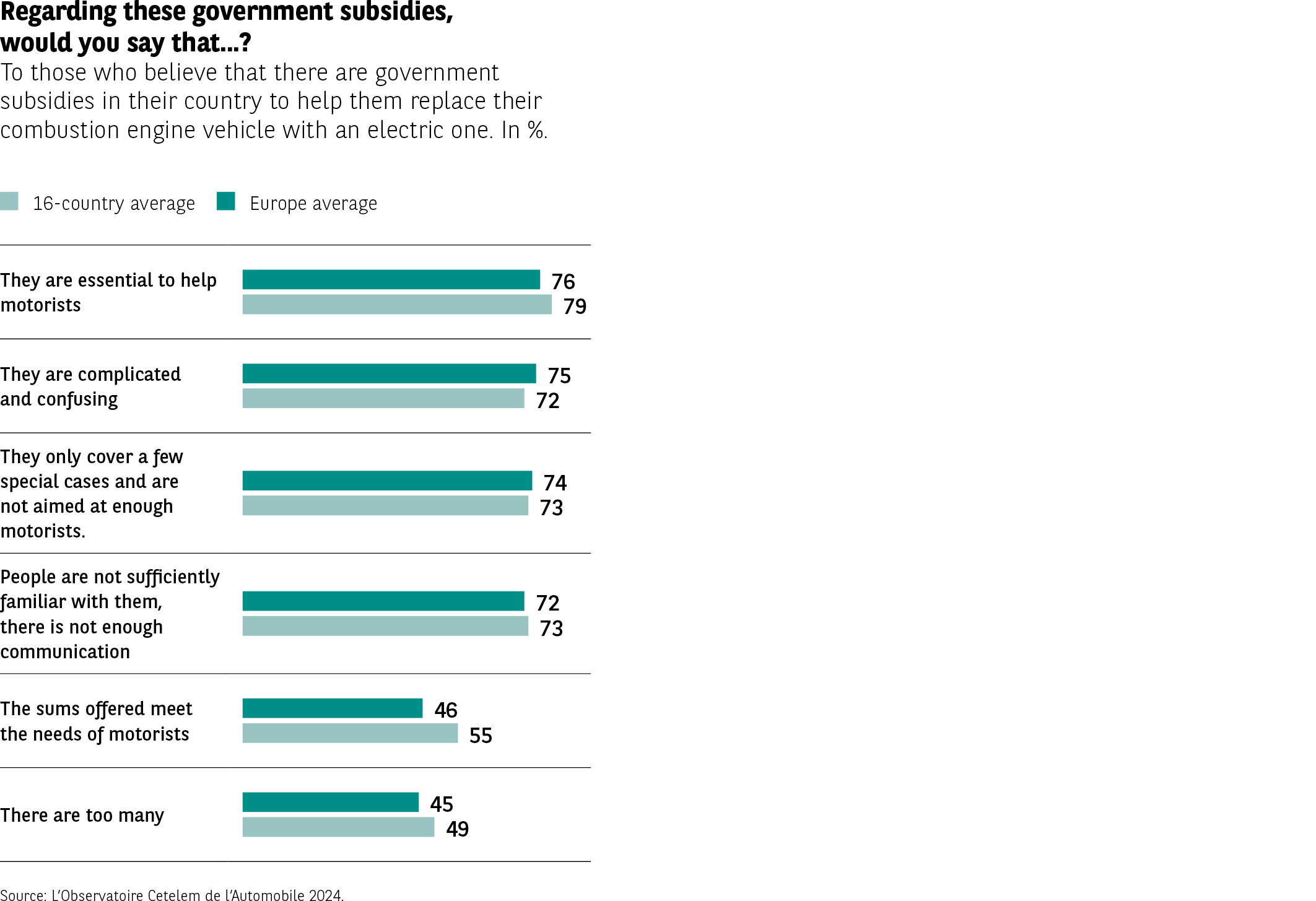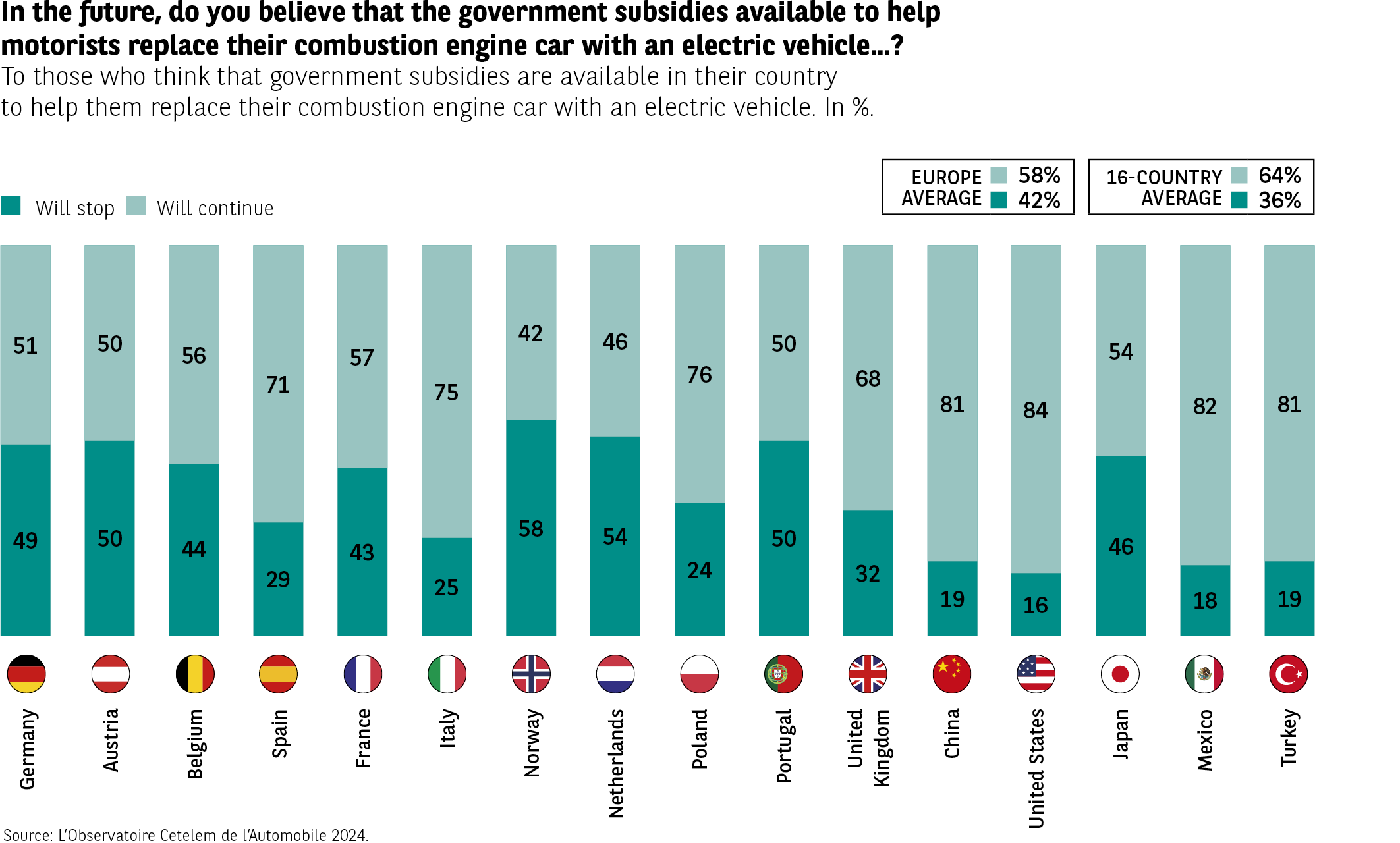Motorists would like support to switch to electric vehicles


Government support is called for across the board
The desire is there, but there are also obstacles. All that is missing is the nudge that could make all the difference. Almost 3 in 4 of those surveyed would like this nudge to take the form of government subsidies to help them switch from internal combustion engines to electric vehicles.
The countries most enthusiastic about electric vehicles are those that are the keenest to receive such support, with Turkey leading the way thanks to an almost unanimous response from its citizens. Even in the United States, a land known for its spirit of free enterprise, such subsidies would be welcomed. Might the Biden plan* have something to do with it? In Austria, and to a lesser extent in Norway and Belgium, demand for measures of this kind is less acute (Fig. 30).
Fig 30 – Support for public electric aids
Download this infographic for your presentations Vertical graph asking:
“Should public authorities financially help individuals replace their thermal vehicle with an electric vehicle?”
Categories
Yes
No
Visual elements
Average of 16 countries
Average of Europe
Results by country
General trend
Support is strongly majority in almost all countries.
The demand for public aid is a central expectation, perceived as necessary for the automotive transition.
Vertical graph asking:
“Should public authorities financially help individuals replace their thermal vehicle with an electric vehicle?”
Categories
Yes
No
Visual elements
Average of 16 countries
Average of Europe
Results by country
General trend
Support is strongly majority in almost all countries.
The demand for public aid is a central expectation, perceived as necessary for the automotive transition.
Knowledge about subsidies is lacking
As we saw previously on the question of cars in general, there is also quite a clear lack of
awareness when it comes to the existence of local subsidies. Just over half of the motorists surveyed have no idea whether any are available in their country. Individuals in the leading European Union countries, with the exception of Belgium, tend to be well informed, unlike in Mexico, Norway and the United Kingdom, where subsidies have been available since 2011 (Fig. 31).
Fig 31 – Knowledge of electric public aids
Download this infographic for your presentations Vertical stacked bar chart “Yes / No” for 16 countries.
Averages: Europe 54% yes / 46% no; 16 countries 54% yes / 46% no.
Visible data (extracts)
Germany: 62 yes / 38 no
Belgium: 30 / 70
France: 66 / 34
Italy: 52 / 48
Norway: 29 / 71
China: 74 / 26
Japan: 47 / 53
Mexico: 27 / 73
Turkey: 41 / 59
Strong disparity: good information in France and China, very low in Belgium and Mexico.
Vertical stacked bar chart “Yes / No” for 16 countries.
Averages: Europe 54% yes / 46% no; 16 countries 54% yes / 46% no.
Visible data (extracts)
Germany: 62 yes / 38 no
Belgium: 30 / 70
France: 66 / 34
Italy: 52 / 48
Norway: 29 / 71
China: 74 / 26
Japan: 47 / 53
Mexico: 27 / 73
Turkey: 41 / 59
Strong disparity: good information in France and China, very low in Belgium and Mexico.
Essential and complex
The necessity of these subsidies is unquestionable. 8 out of 10 people consider them essential. The Chinese, Turks, French, Spanish and Americans are their most vocal supporters. But the fog returns to render the detail behind these measures opaque, once again leaving motorists with doubts and questions.
More than 7 out of 10 respondents find them too confusing. The French and Poles are the most likely to bemoan this complexity, which is often of an administrative nature. They are seen in equal measure as confusing and marred by inadequate communication that hinders awareness. This time, a majority of Turks and Mexicans voice their dissatisfaction on these points.
The fact that this support is only accessible to a limited number of motorists generates a similarly high level of disapproval, the sense being that only the rich benefit, since they alone can afford to buy electric vehicles, which are more expensive than average. This result echoes the feeling of injustice prompted by LEZs, which are seen as penalising low-income households first and foremost. This is a stance that is particularly prevalent in Mexico, the UK, Italy, France and Poland. Setting aside the factors that cause the fog to thicken, the issue of price is the dominant one in most people’s minds.
Lastly, 55% deem the subsidies to be high enough in value. 45% go so far as to say that they are too high (Fig. 32).
Fig 32 – Opinion on existing public aids
Download this infographic for your presentations Comparison between “average of 16 countries” and “average of Europe”.
Six statements, with % of agreement:
Essential: 76% / 79%
Complicated, confusing: 75% / 72%
Reserved for too few cases: 74% / 73%
Not well known: 72% / 73%
Amount adapted: 46% / 55%
Too numerous: 45% / 49%
Aids are perceived as essential but too complex and poorly communicated.
Comparison between “average of 16 countries” and “average of Europe”.
Six statements, with % of agreement:
Essential: 76% / 79%
Complicated, confusing: 75% / 72%
Reserved for too few cases: 74% / 73%
Not well known: 72% / 73%
Amount adapted: 46% / 55%
Too numerous: 45% / 49%
Aids are perceived as essential but too complex and poorly communicated.
Let’s hope it lasts
These subsidies will be just as useful in the future as they are today Just 1 in 5 of those who believe they will remain in force think that they will be reduced. Twice as many are hopeful that they will increase. This hope is expressed by 1 in 2 respondents in China, the United States and Turkey. 45% believe that their value will remain the same, with France, Spain and Mexico being the only countries where this is the majority view (Fig. 33 et 34).
Fig 33 – Future of public aids
Download this infographic for your presentations Categories: “Will disappear” / “Will continue”.
Averages
Europe: 58% will continue / 42% will disappear
16 countries: 64% / 36%
Data by country (examples)
Japan: 54% will continue / 46% will disappear
Mexico: 82 / 18
United States: 16 / 84 (very low continuation)
China: 81 / 19
Very strong belief in continuation in Mexico and Asia; marked skepticism in the United States.
Categories: “Will disappear” / “Will continue”.
Averages
Europe: 58% will continue / 42% will disappear
16 countries: 64% / 36%
Data by country (examples)
Japan: 54% will continue / 46% will disappear
Mexico: 82 / 18
United States: 16 / 84 (very low continuation)
China: 81 / 19
Very strong belief in continuation in Mexico and Asia; marked skepticism in the United States.
Fig 34 – Anticipated evolution of aid amounts
Download this infographic for your presentations Categories:
Will increase
Will remain the same
Will decrease
Averages Europe: 20% / 47% / 33%
Averages 16 countries: 18% / 45% / 37%
Examples
China: 50% increase
Japan: 24% increase / 36% decrease
Turkey: 48% increase
Most think that aids will stabilize or decrease, except in China and Turkey.
Categories:
Will increase
Will remain the same
Will decrease
Averages Europe: 20% / 47% / 33%
Averages 16 countries: 18% / 45% / 37%
Examples
China: 50% increase
Japan: 24% increase / 36% decrease
Turkey: 48% increase
Most think that aids will stabilize or decrease, except in China and Turkey.
